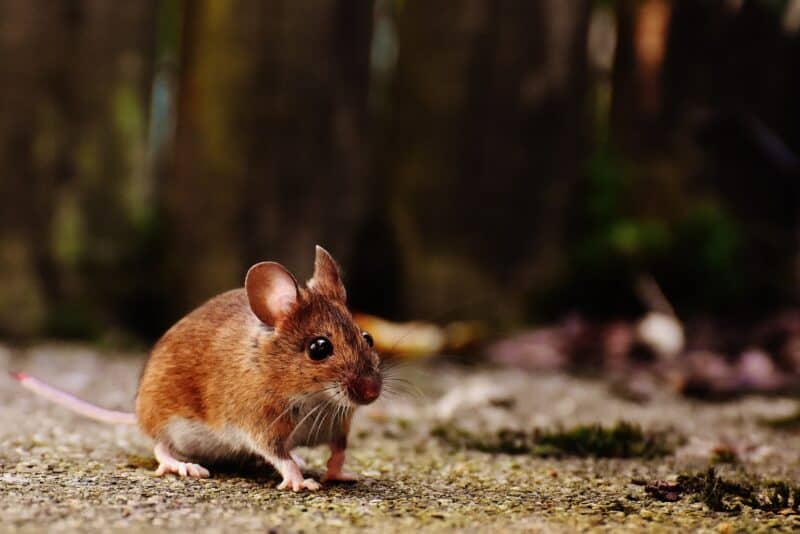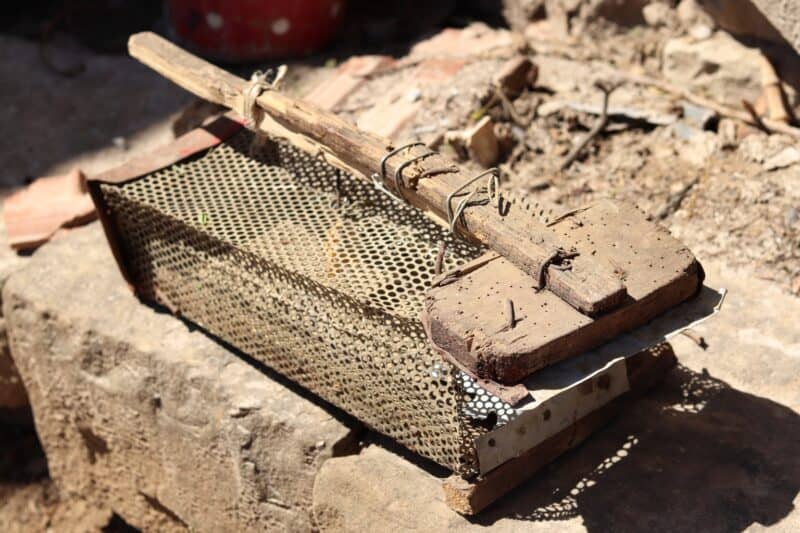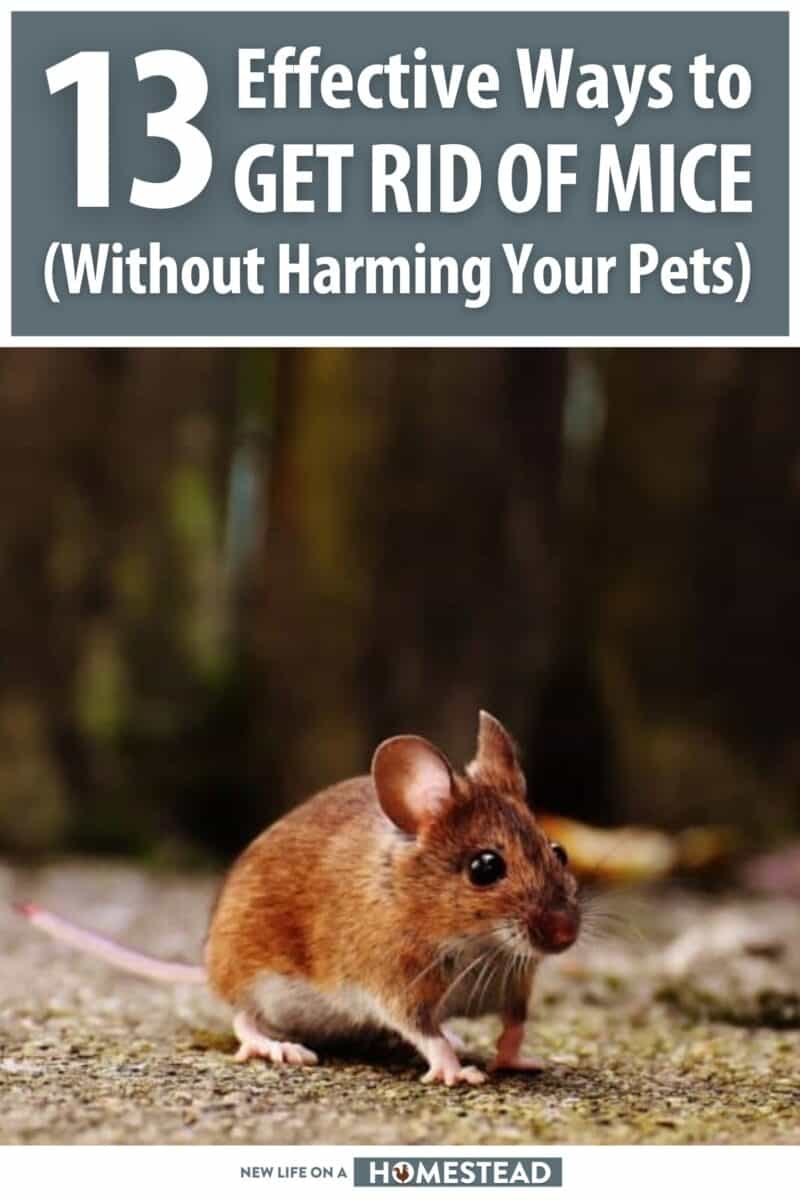If you ever had a mouse problem before, you already know what a pain it is trying to get rid of them.
The little things are pervasive, persistent and evasive, and trying to get rid of them is even harder if you’ve got pets of your own.

Poison is an indiscriminate killer, and lethal mechanical traps can injure your dog or cat. The presence of our furry friends is complicating an already complicated problem!
But believe it or not, it is entirely possible to get rid of mice that are plaguing you without hurting your pets at all. In fact, you might not even need to use anything truly dangerous to do it!
You don’t need to put up with mice just because you have pets, and to prove it, I’m bringing you 13 surefire methods for eliminating mice that won’t catch your pets in the crossfire.
1. Live-Catch Traps
One of my very favorite methods for mouse removal in general, and especially if I have pets around, is a live catch trap.
Sometimes called humane traps, these devices do exactly what they say: they catch mice alive without injury in any way.
Of course, once you’ve caught the mouse it’s up to you to either dispatch it or take it somewhere far away and release it back into the wild.

The best kind that I have used are a small, rectangular box with a gated opening on either end. They are self-arming, self-resetting, and can hold a bunch of mice at once!
They even have a clear top so you can easily see inside to ascertain if you have caught your mark without opening it. Affordable, effective, and totally safe- what’s not to love?
2. Drowner Traps
A drowner trap is a specialized kind of mouse trap that is completely safe to use around larger pets like dogs and cats, though I’d be very cautious using it around birds, small puppies, kittens and other vulnerable creatures.
Basically, a drowner trap is a little more than a bucket filled up about a third of the way with water with ramps leading up to a trapdoor or rotating pole that has bait in the middle.
Mice scurry up the ramp after smelling the bait and walk out on the pole to get before they lose their footing and get dumped into the water. After they tire out, they drown.
No poisons, no spring-loaded mechanism that can injure other pets. Only the smallest pets are vulnerable to falling in themselves.
3. Careful Use of Poison Baits
Now, this might seem counterintuitive based on the title of this article but bear with me. It is entirely possible to use poisons in a responsible and safe way to eliminate mice without endangering your pets.
The trick is to use poisons strategically: put out only the smallest prescribed dosages for mice and place them in areas where your pets absolutely, positively cannot reach.
Also, never mix rat poison in any food that is appealing to pets, such as peanut butter, canned food or anything else.
This means you can’t place them under furniture against a wall we’re in a crevice we’re a cat could possibly reach in and pull it out. So long as you do these things, the risk to your pets is pretty minimal.
4. Electronic Traps
If you like the idea of using a dedicated mouse trap against the little scumbags but you still don’t want to endanger your other pets, electronic traps are probably your best bet.
These traps very literally electrocute mice, and the better ones are only armed after a mouse enters them looking for bait. Once they move in for a nibble, electrodes fatally shock them.
Some high-end models even disarm themselves after a successful kill to further reduce risk to bystander animals.
They can be expensive, but they definitely work and will start depopulating mice immediately. The biggest downside is that they require batteries and do require babysitting.
5. Glue Traps
One of the more gruesome but still one of the safest traps on this list for pets are glue traps. You’ve probably seen these before.
A panel or board is covered with a sticky, tarry substance that holds mice fast until they dehydrate and die. They really do work, but sometimes the poor little things break themselves to pieces trying to get free.
Obviously, you’re going to have a major mess on your hands and probably a trip to the vet if your dog or cat encounters these, so place them responsibly.
But, this is still a far lighter consequence than running into a snap trap or rat poison under the same circumstances.
6. Repellent Sprays
Sometimes the best way to get rid of mice is to incentivize them to leave. This can be done with specialty repellent sprays sold at most hardware stores, sometimes at pet stores, and all are widely available online.
These sprays have all sorts of man-made and natural ingredients that mice, supposedly, cannot stand and will flee from.
When they work, there’s hardly anything easier but they are not foolproof and there is some evidence that many most populations quickly adapt to the presence of these repellents.
Worth a try if for no other reason than they are low impact and pose absolutely no danger to pets.
7. All-Natural Repellent
If you don’t want to go the route of repellent sprays, you might try using natural repellents against mice.
Rodents, including mice, have amazingly delicate noses and they can easily be overwhelmed by certain pungent odors.
Concentrated oils or powders containing peppermint, cayenne or other spicy peppers, garlic and lemongrass might be enough to drive out mice.
This can be especially effective if you use it as an opportunity to shore up your other defenses.
Try sprinkling powders or soaking cotton balls with the stuff before placing them in strategic locations where mice enter or exit.
8. Ultrasonic Deterrents
Ultrasonic mouse deterrents are another technological method that’s safe to use around pets, and before you ask, no, your dogs and cats cannot hear them – supposedly!
These devices work by emitting ultra-high frequency sound waves that will aggravate the living daylights out of mice. In turn, they will flee from the area or at the very least move further away from the emitter.
These can be a good option for protecting more vulnerable areas of your home, places like pantries and so forth, but once again there is some evidence that the adaptable little rodents can actually get used to even this ear-splitting defense.
If it works, it might solve your problems as easily as flipping a switch, so it’s worth a try for your pet’s sake.
9. Mouse-Proof Your Home
One of the most effective ways to get rid of mice also happens to be one of the most laborious, slowest, and least fun. You need to mouse-proof your home!
This is a process of systematically eliminating absolutely any point where mice could make it into your house from the outside, and that includes under your home and up at the roof line.
Any place where a mouse’s skull can fit they can squeeze through, so that’s the target size of any openings.
Next, you need to make your surrounding grounds less attractive to mice…
Eliminate dense foliage and vegetation where you can. Reposition and raise up off the ground stacks of firewood. Get rid of standing water where mice can drink. Things like that.
10. Eliminate Food Sources
This is a technique that goes hand in hand with the previous. Your next order of business after you have sealed up all openings where mice might enter is to get rid of easy sources of food for them.
Sadly, this often includes the food for our pets that we leave out and is definitely stuff like crumbs on the kitchen floor, easily accessed pantries, store rooms, root cellars and so on.
Depending on your lifestyle, this will be easier or harder to do, but it must be done!
You don’t have to go crazy here putting stuff in hermetically sealed jars or anything, but make it a point to keep easily accessible food properly packaged and out of sight where a roaming mouse can’t get to it easily. The harder they have to work for food, the less likely they are to hang around.
11. Let Your Pets Help!
There’s no reason why you can’t get your pets to help you control the mouse problem!
Obviously, cats are extremely efficient terminators of mice, and will most happily kill them at every opportunity.
Letting your cat roam in and around your home when you know mice are on the move will at the very least help to suppress their activities and will all but certainly result in a few kills.
Dogs, especially terriers, can also be remarkably effective at killing mice.
There are some risks to this, naturally, not the least of which is that a mouse could bite your dog or cat but also the likelihood that your canine or feline companion will dismember the poor thing and get blood and guts everywhere!
12. Call in an Exterminator
There’s no shame in calling for professionals when an infestation is properly out of control.
Most exterminators are more than capable of implementing comprehensive, effective solutions to mouse problems without posing the least little bit of harm to people or pets.
Yes, this is the most expensive solution on the list, by far, but when you consider how much your time is worth and how much the health and wellness of your pet is worth, it is often money well spent.
13. Use a Trained Mink or other Predator
The hands-down gnarliest, and also most interesting, method for mouse control is through the use of a trained mink or another apex predator of mice.
I’m not kidding: this is a real service in some places. A mink on the loose is basically doomsday for mice and rats: they are larger, stronger, faster, and can go anywhere that a mouse or rat can go.
Many times introducing one of these animals to the space where the mice are living is enough to see them streaming out of every hole and crevice, running for their lives!
It won’t take long for any that remain in hiding to be brought out clamped in the jaws of these clever mustelids.
And it’s not just minks: specialty dog teams are also used for the purpose in rural areas, and even some kinds of “trained” lizards!

Tom has lived and worked on farms and homesteads from the Carolinas to Kentucky and beyond. He is passionate about helping people prepare for tough times by embracing lifestyles of self-sufficiency.
